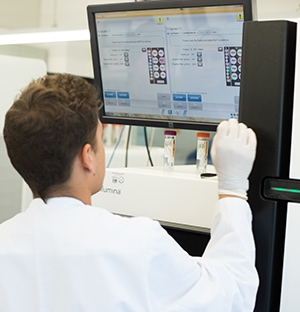Automated testing is a required part of any development but can be hard to achieve when using physical instruments and dynamically changing real-life samples. Here I will describe my solution to this, which impersonates laboratory instruments and randomly generates different sample characteristics. If you are reading this externally I refer to Holly which is our… Continue reading Laboratory Workflow Simulator – Impersonating instruments for automated E2E testing
Solving the lab collaboration puzzle using plugins
In a genomics workflow, we’ll talk about Next Generation Sequencing (NGS) here, there are a lot of very similar steps. These steps pertain to some preparation such as histology and/or extraction, quantification, library preparation, sequencing and bioinformatics (pipeline, curation etc.). Although these steps are largely the same they come in many forms and use many… Continue reading Solving the lab collaboration puzzle using plugins
Tracking data to learn how to sequence
Thousands of variables come in to play throughout the lifecycle of a pathology sample. Due to the sensitive nature of NGS any or all of these could effect the final sequencing quality.Using a suitable LIMS we can track as many or as few variables and feed it back into the system to continuously improve sequencing… Continue reading Tracking data to learn how to sequence
Creating a JQuery plugin for laboratory plate visualization
I develop a LIMS system for a molecular Pathology laboratory and I just build a UI tool for displaying a plate of samples. I thought I would break it out to share. It is still very basic but I hope to add configurations and styles as I get time. Github: https://github.com/gareth-reid/LabPlate-JqueryPlugin I use this in… Continue reading Creating a JQuery plugin for laboratory plate visualization
Simple tool to count genomic base occurrences
This is a simple tools to count the occurence of each base at a specified genomic coordinate. It is simply to illustrate how to use the vast array of existing bioinformatics tools with some basic code of your own & without the need to use R for simple projects. Purpose: This piece of software uses… Continue reading Simple tool to count genomic base occurrences
Protected: Miller Finn Reid from House to Joy
There is no excerpt because this is a protected post.
Simplifying the pathology LIMS puzzle using Object Oriented Programming 101
I wanted to illustrate how I built a basic system to fill the needs of alternate commercial options that use 100s of developers years to build the perfect solution.
A Beating Heart – Highcharts animation example
Further to my last post about highcharts thought I would show how we can graph any set of data in the form of a heart graph example. Using the line graph, Ajax and Highcharts animation we can create a live graph powered by data coming from the server. Graph saved as GIF Is much smoother… Continue reading A Beating Heart – Highcharts animation example
Explanation of Molecular Modelling
The molecular dynamics method. By analysing a molecular system using physics, specifically the laws of motion and energy, one can model the movements of atoms within a 3d space or medium. By treating all atoms as ‘balls’ the motions can be calculated based on their interactions with other atoms. These interactions are derived using four main… Continue reading Explanation of Molecular Modelling
Introduction to Protein Folding
This is a basic description of what a protein is, what they become and the relevance of molecular modelling, as I didn’t really explain this in that blog. Cells are made of proteins. To build a protein, a cell uses the codes stored in its DNA to gather a group of Amino Acids (AA), a list if you will.… Continue reading Introduction to Protein Folding
